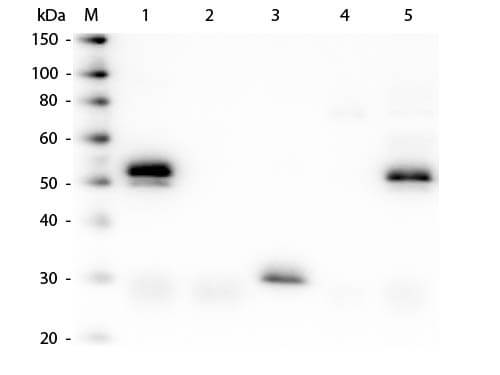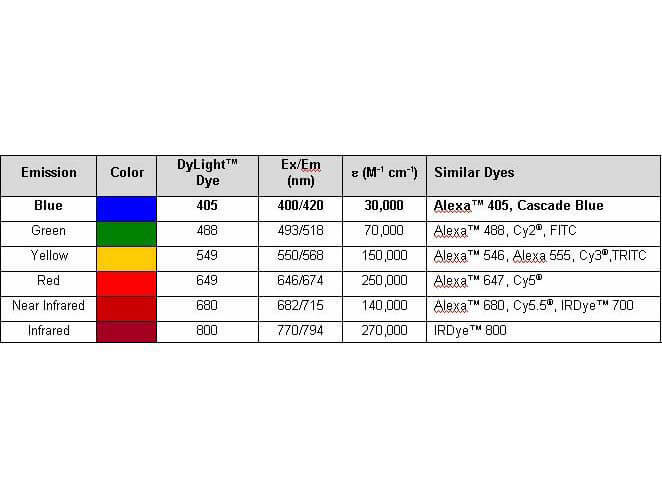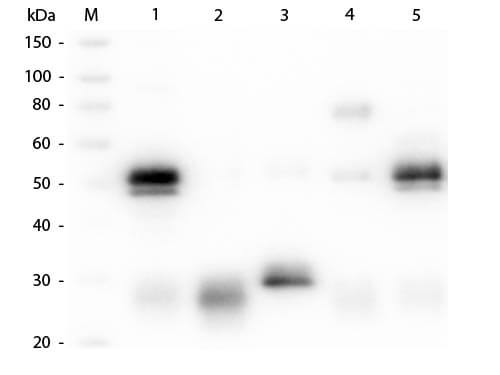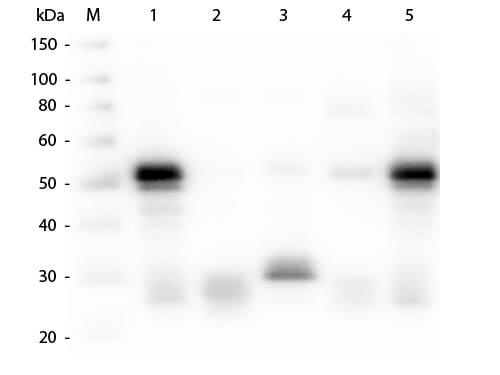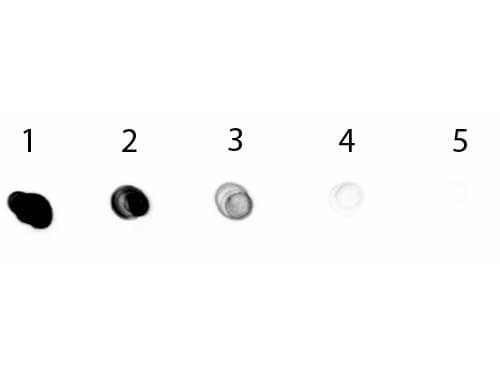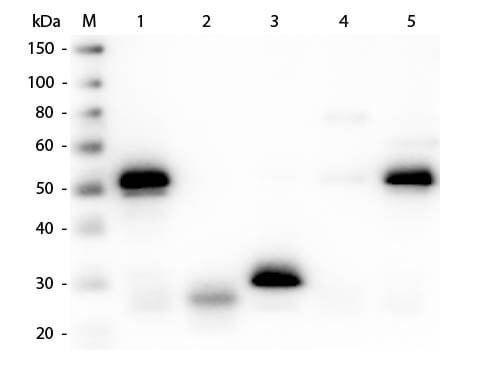Datasheet is currently unavailable. Try again or CONTACT US
Rabbit IgG (H&L) Antibody DyLight™ 649 Conjugated Pre-Adsorbed
Donkey Polyclonal
8 References
611-743-127
100 µg
Lyophilized
IHC, IF, Dot Blot, Multiplex
Rabbit
Donkey
Shipping info:
$50.00 to US & $70.00 to Canada for most products. Final costs are calculated at checkout.
Product Details
Donkey Anti-Rabbit IgG (H&L) Antibody DyLight™ 649 Conjugated (Min X Bv Ch Gt GP Ham Hs Hu Ms Rt & Sh Serum Proteins) - 611-743-127
Donkey Anti-Rabbit IgG Antibody DyLight 649™ Conjugated, Donkey Anti Rabbit IgG DyLight 649™ Conjugated Antibody
Donkey
IgG (H&L)
DyLight™ 649
Polyclonal
IgG
Target Details
Rabbit
Rabbit IgG whole molecule
This product was prepared from monospecific antiserum by immunoaffinity chromatography using Rabbit IgG coupled to agarose beads followed by solid phase adsorption(s) to remove any unwanted reactivities. Assay by immunoelectrophoresis resulted in a single precipitin arc against anti-Donkey Serum, Rabbit IgG and Rabbit Serum. No reaction was observed against Bovine, Chicken, Goat, Guinea Pig, Hamster, Horse, Human, Mouse, Rat and Sheep Serum Proteins. This antibody will react with heavy chains of rabbit IgG and with light chains of most rabbit immunoglobulins.
Application Details
Dot Blot
IF, IHC, Multiplex
- View References
Anti-Rabbit IgG (H&L) DyLight 649 Antibody has been tested by dot blot and is designed for immunofluorescence microscopy, fluorescence based plate assays (FLISA) and fluorescent western blotting. This product is also suitable for multiplex analysis, including multicolor imaging, utilizing various commercial platforms. The emission spectra for this DyLight™ conjugate match the principle output wavelengths of most common fluorescence instrumentation.
Formulation
1.0 mg/mL by UV absorbance at 280 nm
0.02 M Potassium Phosphate, 0.15 M Sodium Chloride, pH 7.2
0.01% (w/v) Sodium Azide
10 mg/mL Bovine Serum Albumin (BSA) - Immunoglobulin and Protease free
100 µL
Restore with deionized water (or equivalent)
Shipping & Handling
Ambient
Store vial at 4° C prior to restoration. For extended storage aliquot contents and freeze at -20° C or below. Avoid cycles of freezing and thawing. Centrifuge product if not completely clear after standing at room temperature. This product is stable for several weeks at 4° C as an undiluted liquid. Dilute only prior to immediate use.
Expiration date is one (1) year from date of receipt.
Anti-Rabbit IgG (H&L) DyLight 649 Antibody generated in donkey detects reactivity to Rabbit IgG. Secreted as part of the adaptive immune response by plasma B cells, immunoglobulin G constitutes 75% of serum immunoglobulins. Immunoglobulin G binds to viruses, bacteria, as well as fungi and facilitates their destruction or neutralization via agglutination (and thereby immobilizing them), activation of the compliment cascade, and opsonization for phagocytosis. The whole IgG molecule possesses both the F(c) region, recognized by high-affinity Fc receptor proteins, as well as the F(ab) region possessing the epitope-recognition site. Both the Heavy and Light chains of the antibody molecule are present. Secondary Antibodies are available in a variety of formats and conjugate types. When choosing a secondary antibody product, consideration must be given to species and immunoglobulin specificity, conjugate type, fragment and chain specificity, level of cross-reactivity, and host-species source and fragment composition.
Ayyar BV et al. (2023). CLIC and membrane wound repair pathways enable pandemic norovirus entry and infection. Nat Commun.
Applications
IF, Confocal Microscopy
Onoda A et al. (2022). A Novel Staining Method for Detection of Brain Perivascular Injuries Induced by Nanoparticle: Periodic Acid-Schiff and Immunohistochemical Double-Staining. Front Toxicol.
Applications
IF, Confocal Microscopy
Onoda A, Kawasaki T, Tsukiyama K, Takeda K, Umezawa M. (2020). Carbon nanoparticles induce endoplasmic reticulum stress around blood vessels with accumulation of misfolded proteins in the developing brain of offspring. Sci Rep.
Applications
IF, Confocal Microscopy; Multiplex Assay
Onoda et al. (2017). Dose-dependent induction of astrocyte activation and reactive astrogliosis in mouse brain following maternal exposure to carbon black nanoparticle. Particle and Fibre Toxicology
Applications
IF, Confocal Microscopy; Multiplex Assay
Onoda et al. (2017). Perivascular Accumulation of β-Sheet-Rich Proteins in Offspring Brain following Maternal Exposure to Carbon Black Nanoparticles. Frontiers in Cellular Neuroscience
Applications
IF, Confocal Microscopy; Multiplex Assay
Krzisch M, Fülling C, Jabinet L, et al. (2017). Synaptic Adhesion Molecules Regulate the Integration of New Granule Neurons in the Postnatal Mouse Hippocampus and their Impact on Spatial Memory. Cereb Cortex.
Applications
IHC, ICC, Histology
Lee DK et al. (2016). Microvascular endothelial cells from preeclamptic women exhibit altered expression of angiogenic and vasopressor factors. Am J Physiol Heart Circ Physiol.
Applications
IF, Confocal Microscopy
Tanase JI et al. (2016). Magnesium chloride and polyamine can differentiate mouse embryonic stem cells into trophectoderm or endoderm. Biochem Biophys Res Commun.
Applications
IF, Confocal Microscopy
This product is for research use only and is not intended for therapeutic or diagnostic applications. Please contact a technical service representative for more information. All products of animal origin manufactured by Rockland Immunochemicals are derived from starting materials of North American origin. Collection was performed in United States Department of Agriculture (USDA) inspected facilities and all materials have been inspected and certified to be free of disease and suitable for exportation. All properties listed are typical characteristics and are not specifications. All suggestions and data are offered in good faith but without guarantee as conditions and methods of use of our products are beyond our control. All claims must be made within 30 days following the date of delivery. The prospective user must determine the suitability of our materials before adopting them on a commercial scale. Suggested uses of our products are not recommendations to use our products in violation of any patent or as a license under any patent of Rockland Immunochemicals, Inc. If you require a commercial license to use this material and do not have one, then return this material, unopened to: Rockland Inc., P.O. BOX 5199, Limerick, Pennsylvania, USA.


